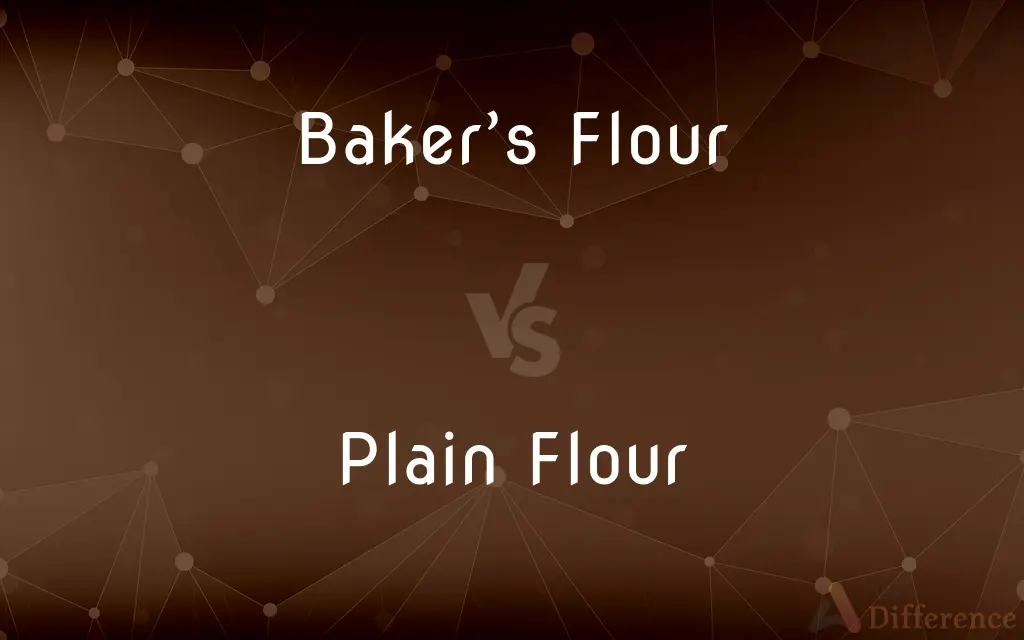Baker’s Flour vs. Plain Flour — What's the Difference?
By Tayyaba Rehman — Published on November 29, 2023
Baker's Flour is a high-protein flour ideal for bread-making, while Plain Flour is a general-purpose, all-around flour with medium protein content.

Difference Between Baker’s Flour and Plain Flour
Table of Contents
ADVERTISEMENT
Key Differences
Baker's Flour, often termed as bread flour, is specifically milled for baking purposes. Its higher protein content, usually around 12-14%, aids in the formation of gluten, which gives bread its characteristic chewiness. Plain Flour, on the other hand, is versatile and can be used in various recipes, from pastries to sauces, due to its moderate protein content, typically around 8-11%.
The gluten formation potential of Baker's Flour makes it an exceptional choice for bread and similar baked goods. It ensures the dough's elasticity and strength, resulting in a high-rise and a firm structure. In contrast, Plain Flour with its medium gluten potential is a jack-of-all-trades in the baking world. It's reliable for cakes, cookies, and many dishes that do not require significant gluten development.
Baker's Flour is specifically crafted to optimize the bread-making process. The consistency it provides is perfect for the fermentation that bread undergoes, giving it a distinct taste and texture. Plain Flour, while versatile, might not always give the best results in bread-making but is excellent for recipes that call for a tender crumb.
For many home bakers and chefs, Plain Flour is a pantry staple due to its flexibility. It's often the go-to for most recipes, as it strikes a balance between protein and starch. Baker's Flour, however, is a specialized flour and might be sought after by those keen on making bread or similar baked goods.
In culinary schools and among professional bakers, the distinction between Baker's Flour and Plain Flour is crucial. While both are made from wheat, their unique properties, stemming from their protein content and processing methods, dictate their best uses in the kitchen.
ADVERTISEMENT
Comparison Chart
Protein Content
High (around 12-14%).
Medium (around 8-11%).
Best Used For
Bread-making due to gluten formation.
General baking like cakes, cookies, sauces.
Gluten Formation
High potential.
Moderate potential.
Versatility in Baking
Specialized for bread and similar products.
Versatile, used in a variety of recipes.
Presence in Common Recipes
Frequently in bread recipes.
Found in most general baking recipes.
Compare with Definitions
Baker’s Flour
Specifically milled for baking purposes.
The croissants made with Baker's Flour had a strong structure.
Plain Flour
Can be enriched with added vitamins and minerals.
The muffins made with enriched Plain Flour were nutritious.
Baker’s Flour
Preferred for recipes requiring fermentation.
The sourdough bread's rise was perfect due to the Baker's Flour.
Plain Flour
Often the primary flour in a home baker's pantry.
For the roux, she chose Plain Flour as it was versatile.
Baker’s Flour
High-protein flour ideal for bread-making.
The artisanal loaf was made using Baker's Flour to achieve its chewy texture.
Plain Flour
Strikes a balance between protein and starch.
The pancakes were light and airy, thanks to the Plain Flour.
Baker’s Flour
Often synonymous with bread flour in recipes.
The recipe called for Baker's Flour to ensure a high-rise.
Plain Flour
General-purpose flour with medium protein content.
She used Plain Flour to bake a soft, fluffy cake.
Baker’s Flour
Flour that aids in optimal gluten formation.
For the pizza dough, the chef chose Baker's Flour for its elasticity.
Plain Flour
Suitable for a broad range of baking recipes.
The cookies made with Plain Flour had a tender crumb.
Common Curiosities
Can I use Baker's Flour for cakes and cookies?
It's possible, but the texture might differ due to the flour's high gluten potential.
What distinguishes Baker's Flour from Plain Flour?
Baker's Flour has higher protein content, making it ideal for bread, while Plain Flour is versatile with medium protein.
Can I mix Plain Flour and Baker's Flour?
Yes, mixing can help achieve a desired texture based on the recipe's requirements.
Does the source of wheat affect the flour type?
Yes, different wheat varieties can influence protein content and flour properties.
Does Plain Flour work for thickening sauces?
Absolutely, Plain Flour is often used as a thickening agent in sauces and gravies.
Can I use Plain Flour instead of Baker's Flour for bread?
While possible, bread made with Plain Flour may not have the desired chewiness and structure.
Is Baker's Flour the same as bread flour?
Yes, Baker's Flour is often synonymous with bread flour.
What protein content does Plain Flour usually have?
Typically, Plain Flour has a protein content of around 8-11%.
Is there a significant taste difference between the two?
Taste is often similar, but the texture of the end product can vary due to the flour type.
Why is Baker's Flour preferred for bread-making?
Its high protein content aids in gluten formation, giving bread its characteristic texture.
Can I make my blend of Baker's Flour?
While specialized, one can mix high-protein flour with other types to mimic Baker's Flour.
Can I use either flour for gluten-free recipes?
No, both Baker's Flour and Plain Flour contain gluten, so they aren't suitable for gluten-free recipes.
How should I store both flours?
Both should be stored in a cool, dry place, preferably in airtight containers.
Are there any other flours apart from these?
Yes, there are numerous flours like whole wheat, pastry flour, self-raising, and many more.
Is gluten content the main difference between Baker's Flour and Plain Flour?
Gluten potential, influenced by protein content, is a primary distinction, but milling processes and intended uses also vary.
Share Your Discovery

Previous Comparison
Offer Letter vs. Letter of Intent
Next Comparison
Cash Market vs. Future MarketAuthor Spotlight
Written by
Tayyaba RehmanTayyaba Rehman is a distinguished writer, currently serving as a primary contributor to askdifference.com. As a researcher in semantics and etymology, Tayyaba's passion for the complexity of languages and their distinctions has found a perfect home on the platform. Tayyaba delves into the intricacies of language, distinguishing between commonly confused words and phrases, thereby providing clarity for readers worldwide.
















































